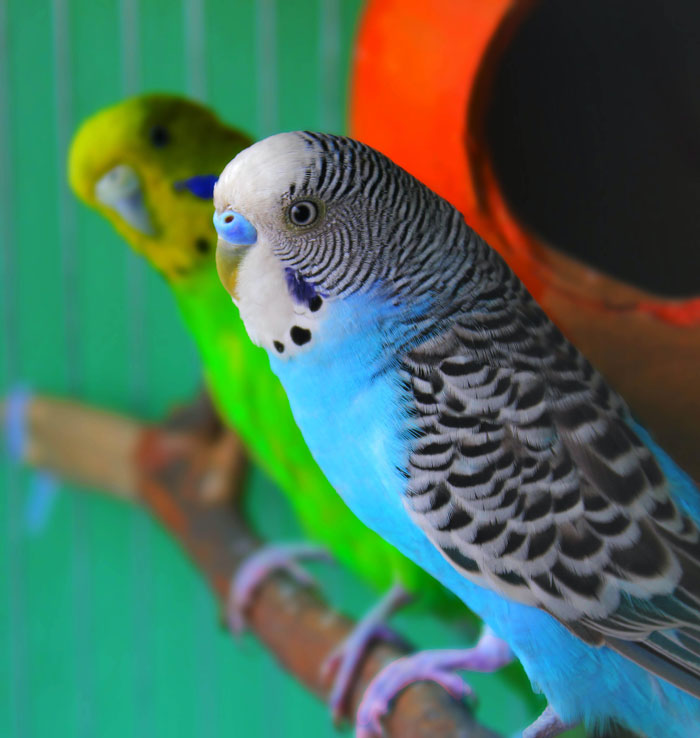Just like humans, budgies can confront eye problems. Some of these eye problems are minor ones which you can easily take care of and major ones that require medical intervention. What are the things you do when your bird has an eye problem? The article provides some useful and practical information. First, you have to know the common eye issues in budgies.
Common Eye Issues & infections in Budgies
|
Budgies' eyes are wonderful, yet they face lots of problems. The most common eye issues in budgies include:
- Mycobacteriosis
- Psittacosis
- Salmonellosis
- Vitamin A Deficiency
- Eye Infection
|
 |
1.Mycobacteriosis
Mycobacteriosis is an infection in birds and animals which is caused by bacteria in the Mycobacterium genus. Mycobacterium Genavense and Mycobacterium Avium are the main organisms that cause the disease and are found in budgies and parrots in frequent numbers. The hepatic and gastrointestinal systems of the bird are majorly affected. This disease is highly dangerous, fatal and contagious. Your bird will die if it is not treated quickly. Birds can contact Mycobacteriosis through various ways, including contaminated water, bacterium shed in feces, food sources, etc.
Symptoms include lethargy, labored Breathing, diarrhea, increased Urination, gradual wasting, weight loss and poor feather condition.
If your budgie has this infection and it is not the early stages of the disease, you have to euthanize the bird. In the case of the early stage of the disease, you can treat the bird by using antibiotics and anti-tuberculosis. If you have a large group of birds with the infection, you just have to destroy all of them.
2.Psittacosis
Several bacteria cause this infection, but Chlamydophila Avium, Chlamydophila Psittaci, and Chlamydophila gallinaceum are the most common ones. It is severely contagious and can get transmitted from one bird to another or from a bird to a mammal.
The symptoms in budgies can be dormant since birds can hide their diseases. Yet, the symptoms start to show around 3 to 6 days after infection.
The symptoms are: puffy and swollen eyes, conjunctivitis, anorexia, lethargy and fluffed feathers. In order to treat your budgie, you have to make use of doxycycline for 45 days until your budgie recovers completely.
3.Salmonellosis
The infection occurs when bacteria from the genus Salmonella affects the bird’s intestinal tract. Budgies can get infected when they feed on contaminated foods and water. The symptoms include lethargy, diarrhea and ruffled feathers. For the treatment, you should use kaolin-based medications. Provide them with enough clean water to keep them from dehydrating. Make sure your budgie eats well.
4.Vitamin A Deficiency
Lack or deficiency of vitamin A affects the bird’s activities and makes it unable to do some of its task. Most vitamin A deficiency results from inadequate feeding and a poor diet. Conjunctivitis, sneezing, nasal Discharge, polyuria, dyspnea, poor feather quality and anorexia are some of the symptoms. In order to treat your budgie, improve the quality of its diet. Some medications like parenteral vitamin A are suggested as well.
5. Eye infection
Budgie eye infection is not often life threatening but should be taken care of as soon as possible as conjunctivitis, sinusitis, mites and infection can result in permanent blindness and death.
Symptoms of Eye Infection
Some of the symptoms include:
- Swollen, Red, or Irritated Eyes
- Crusty and Watery Eyes
- Cloudy Eyes and Facial Swelling
- Lids closed or partially closed
- Increased blinking
- Squinting
- Excessive tearing wet or dried discharge or even eyes matted shut
- Rubbing the eye, beak or the side of the face on their wing or perch
Budgie eye infection treatment and medicine
The use of antibiotics is considered the best way of treatment. Making use of saline flushes, lincomycin, ophthalmic ointments, spectinomycin and adding Tylosin tartrate to the drinking water are some other ways as well. Controlling the budgie's diet is essential. Feed them every necessary nutrient and neat water. Remove the infected bird from the cage to clean out its cage and provide a proper home for it.
Budgie eye infection home remedy
- Wipe the eye with water: As the budgie's eyes are sensitive, you have to clean them. Put a soft cloth in warm water. Gently wipe the bird’s eye to remove the buildup around the membrane. Avoid touching your bird's eyeball.
- Clean any debris: there could be some dust or cracker crumbs in there. Your bird may get conjunctivitis if debris gets into its eye. This can cause irritation and swelling. If there is any debris in the eye, use a warm damp cloth to remove it.
- Use eye drops: dropping sterile eye drops into the eye could be of help to the bird. This keeps the eye lubricated.
Conjunctivitis
Conjunctivitis is another common health issue among budgies. Tearing, facial swelling, sneezing, watery eyes, crusty eyes, eye and nostril discharge, swollen sinuses, inflammation in the eyelids, sensitivity to light , weakness in eyelid, deposits on cornea, blindness, starvation, listlessness and reduced jaw tone are some of the symptoms.
Bacteria, fungus, parasites, virus attacks, orbital disease, vitamin A deficiency, environmental toxin and poor hygienic condition cause the issue. Feed the bird with seeds and fruits that are rich in vitamin A. Using saline flushes and antibiotics could be of help. Continue the process of treatment for 14 days. You'd better give your bird prescription medication. Your vet may prescribe topical medication, like ointment or drops or maybe oral medications, antibiotic ointments, or sprays for the bird. For fungal infections, the vet prescribes topical antifungal.
All in all, taking your budgie to a vet will be the best choice. You may make the situation worse if you use some medicine without a vet's prescription.
